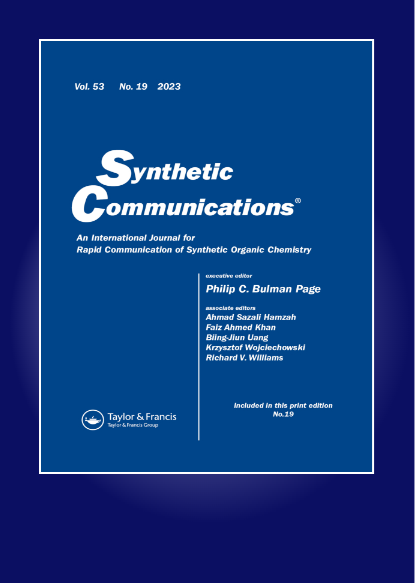Stereoselective construction of 2,3,4-trisubstituted tetrahydrofuran core using NBS mediated cyclization
IF 1.8
3区 化学
Q3 CHEMISTRY, ORGANIC
引用次数: 0
Abstract
An efficient asymmetric construction of chiral trisubstituted tetrahydrofuan core 1 achieved using D-mannitol as chiral starting material. The chiral glyceraldehyde, derived from D-mannitol, converted into alkene which on Clainsen rearrangement converted into chiral 2-substitutedpent-4-enal. The chiral aldehyde on reduction followed by protection subjected for allylic oxidation and afforded diastereomeric inseparable mixture of alcohols 3 and 3′. The mixture of 3 and 3′ was converted into separable mixture of benzyl ethers 2 and 2′. To confirm the stereochemistry of 2 and 2′, they were converted into acetonides 12 and 12′, respectively. Rychnovsky’s method was employed to confirm the absolute stereochemistry of 12 and 12′. Compound 2′ was converted into its diastereomer 2 by using Mitsunobu protocol. The compound 2 was converted into target compound 1 through NBS mediated cyclization. The stereochemistry of chiral trisubstituted tetrahydrofuran core 1 was resembling to THF core present in natural products Aureonitol and Musanahol.
用NBS介导环化立体选择性构建2,3,4-三取代四氢呋喃核
以d -甘露醇为手性起始原料,实现了手性三取代四氢呋喃核1的高效不对称结构。由d -甘露醇衍生的手性甘油醛转化为烯烃,烯烃经Clainsen重排转化为手性2-取代戊烯醛。手性醛在还原后受到烯丙基氧化的保护,得到不可分离的非对映体醇3和3′混合物。将3′和3′的混合物转化为苯醚2和2′的可分离混合物。为了确认2和2 ‘的立体化学性质,将它们分别转化为乙氧化物12和12 ’。采用Rychnovsky的方法确定了12和12 '的绝对立体化学性质。用Mitsunobu法将化合物2′转化为非对映体2。化合物2通过NBS介导的环化转化为目标化合物1。手性三取代四氢呋喃核1的立体化学性质与天然产物金桂醇和木参醇中的四氢呋喃核相似。
本文章由计算机程序翻译,如有差异,请以英文原文为准。
求助全文
约1分钟内获得全文
求助全文
来源期刊

Synthetic Communications
化学-有机化学
CiteScore
4.40
自引率
4.80%
发文量
156
审稿时长
4.3 months
期刊介绍:
Synthetic Communications presents communications describing new methods, reagents, and other synthetic work pertaining to organic chemistry with sufficient experimental detail to permit reported reactions to be repeated by a chemist reasonably skilled in the art. In addition, the Journal features short, focused review articles discussing topics within its remit of synthetic organic chemistry.
 求助内容:
求助内容: 应助结果提醒方式:
应助结果提醒方式:


